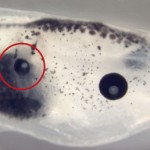Eyes from ions
Scientists use charged molecules to grow eyes in tadpole guts

A new experiment may seem too odd to be true: Scientists have found a way to grow an eye in a tadpole’s gut. The view from the third eye is probably unappealing, but the study shows how electric charges can be used to coax cells to grow in surprising ways.
It also offers a new look at a possible way to regenerate, or regrow, larger limbs. Michael Levin, a biologist at Tufts University in Medford, Mass., led the study. He told Science News that people who have lost arms or legs may one day be able to wear a special device to grow a replacement.
The new experiment “opens up a huge door to new therapies in regenerative medicine using electricity,” developmental biologist Jim Coffman told Science News. Coffman, who works at Mount Desert Island Biological Lab in Salisbury Cove, Maine, did not work on the new study.
Cells make up every part of an animal’s body, including its eyes and guts. Surrounding a cell is a membrane that, like the walls of a house, keeps the inside in and the outside out. Ion channels, doorlike structures on the membrane, let molecules called ions enter and exit the cell.
Ions carry electric charges, which are responsible for electricity. When ions travel in and out of a cell, they change its electric charge. The difference between the charge inside the cell and the charge outside of it is called the membrane potential.
Levin and his team focused on the membrane potential. First, they studied newly formed frog eggs. They found that less than one day after the eggs started to grow, the membrane potential plummeted in the cells that eventually grow into eyes. When the scientists injected chemicals to prevent the membrane potential from dropping, the eyes didn’t grow. The researchers suspected they’d found a connection between the drop in membrane potential and eye growth, but they weren’t sure yet.
To test this link, the team turned to cells in the tadpoles’ guts. The scientists inserted into those cells new ion channels that allowed ions to come and go, which meant the team could control the membrane potential. The researchers tuned the gut cells to have the same membrane potential as the eye cells. Just as they’d hoped, new eyes grew in the gut.
There’s still much work to be done to understand why electric charges can be used to grow new eyes in unusual places. “It is very intriguing and very interesting, but of course, the mechanism is not well understood,” biologist Panagiotis Tsonis told Science News. Tsonis, of the University of Dayton, Ohio, said he doubts that electrical stimulation could produce similar success when growing new organs from cells in lab dishes.
Scientists used to believe that only certain cells grow into eyes, but the new experiment shows that isn’t the case. The new study suggests eyes can be grown anywhere on the body (which might inspire your next Halloween costume).
POWER WORDS (adapted from the New Oxford American Dictionary)
cell The smallest structural and functional unit of an organism, typically microscopic and enclosed in a membrane.
ion An atom or molecule with an electric charge due to the loss or gain of one or more electrons.
membrane A microscopic layer of molecules that surrounds and contains cells and organelles and forms structures within cells.
molecule A group of atoms bonded together.
biology The study of life.







